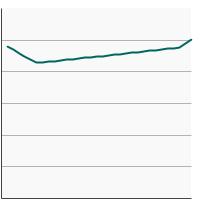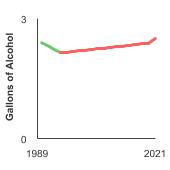On This Page:
- Background
- Measure
- Healthy People 2030 Target
- Data Source
- Trends and Most Recent Estimates
- Related Cancers
- Additional Information
Background
Drinking alcohol increases the risk of cancers of the mouth, esophagus, pharynx, larynx, liver, colon, and rectum in men and women and of breast cancer in women. In general, these risks increase after about one daily drink for women and two daily drinks for men. (A drink is defined as 12 ounces of regular beer, 5 ounces of wine, or 1.5 ounces of 80-proof liquor.)
The chances of getting liver cancer increase markedly with five or more drinks per day. Heavy alcohol use may also increase the risk of colorectal cancer and leads to greater increases in risk for most of the alcohol-related cancers. The sooner long-term, heavy alcohol use begins, the greater the cancer risk. Also, using alcohol with tobacco is riskier than using either one alone because it further increases the chances of getting cancers of the mouth, throat, and esophagus.
Measure
Per capita alcohol consumption: The estimated number of gallons of pure alcohol consumed per person (aged 14 years and older), per year. This measure accounts for the varying alcohol content of wine, beer, and liquor. People as young as 14 are included because a large number of adolescents begin drinking at an early age.
Data Source
National Institute on Alcohol Abuse and Alcoholism. Surveillance report #120 – Apparent per capita alcohol consumption: national, state, and regional trends, 1977–2021. April 2023.
Healthy People 2030 Target
- There are no Healthy People 2030 targets regarding per capita alcohol consumption, but there are other goals related to reducing the misuse of alcohol and reducing alcohol addiction.
Healthy People 2030 is a set of goals set forth by the Department of Health and Human Services.
Trends and Most Recent Estimates
Alcohol Consumption
| Overview Graph | Detailed Trend Graphs | Most Recent Estimates (2021) | |
|---|---|---|---|
| Gallons of Alcohol | 95% Confidence Interval | ||
  |
All Types of Alcoholic Beverages |
2.5 | Not available |
Additional Information
- Alcohol and Cancer Risk. National Cancer Institute.
- Alcohol Use and Cancer. American Cancer Society.
- Alcohol’s Effects on Health. National Institute on Alcohol Abuse and Alcoholism.
- Unhealthy Alcohol Use in Adolescents and Adults: Screening and Behavioral Counseling Interventions. U.S. Preventive Services Task Force.
- 2020-2025 Dietary Guidelines for Americans. U.S. Department of Agriculture and U.S. Department of Health and Human Services.
- Global Cancer Update Programme. World Cancer Research Fund International.
- Diet, Nutrition, Physical Activity, and Cancer: a Global Perspective. World Cancer Research Fund and the American Institute for Cancer Research.
- Alcohol abuse in cancer patients: a shadow side in the oncological field and research. Glasdam S, Oye C. Med Health Care Philos. 2013;17(3):437-46.
- American Cancer Society guideline for diet and physical activity for cancer prevention. Rock CL, Thomson C, Gansler T, et. al. CA Cancer J Clin. 2020; 70(4): 245-271.
- Food Intakes, U.S. Population, 2007-10: Usual Daily Intake of Alcoholic Drinks. National Cancer Institute.
